These days people get deliveries from the FedEx guy. A century and a half ago people got deliveries from the FedOx guy. Fort Worth’s first FedOx guy was John White. White was an ox freighter: In the 1850s and 1860s, before the railroads, White drove an ox-drawn wagon, hauling goods from Fort Worth to Houston and Galveston, hauling goods from Houston and Galveston back to Fort Worth.
White was born in Germany on January 9, 1819 and came to America as a teenager. In 1843 he married Nancy Jane Gipson in Missouri, and the couple moved to Texas. By 1853, according to Howard Peak in the June 11, 1922 Star-Telegram, White was freighting for the army’s Fort Worth. Peak in 1856 was the second child born in Fort Worth.
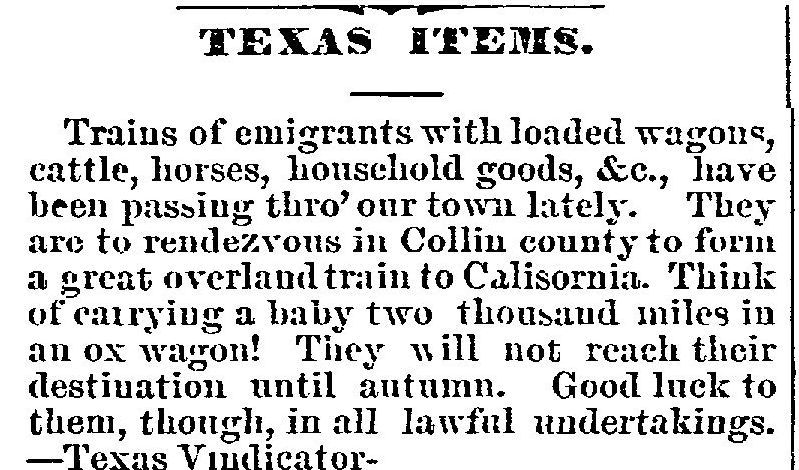 Wagons drawn by horses or oxen weren’t driven by just freighters. Wagons were the woodies of the old West: primitive station wagons into which people loaded family and belongings as they set out to migrate westward to settle, many of them in Peters Colony. On May 16, 1869 the San Antonio Express quoted the Texas Vindicator of Paris. Wagon trains of emigrants were passing through Paris, and the Vindicator predicted that the travelers would not complete their two thousand-mile trip by ox wagon “until autumn.”
Wagons drawn by horses or oxen weren’t driven by just freighters. Wagons were the woodies of the old West: primitive station wagons into which people loaded family and belongings as they set out to migrate westward to settle, many of them in Peters Colony. On May 16, 1869 the San Antonio Express quoted the Texas Vindicator of Paris. Wagon trains of emigrants were passing through Paris, and the Vindicator predicted that the travelers would not complete their two thousand-mile trip by ox wagon “until autumn.”
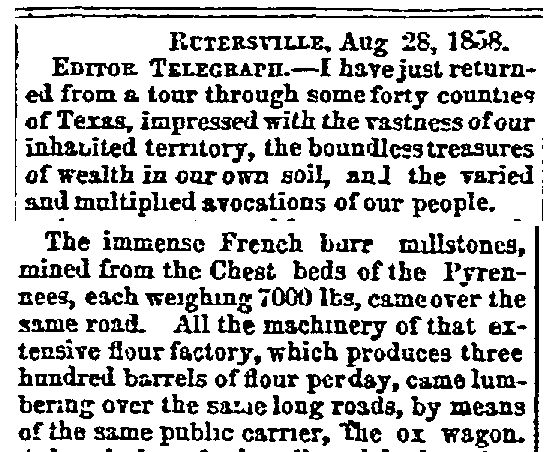 A few yokes (pairs) of oxen were capable of pulling a lot of weight. On September 15, 1858 the Weekly Houston Telegraph reported that all the machinery of a flour mill, including seven-thousand-pound millstones from Europe’s Pyrenees Mountains, had been delivered by “the same public carrier, the ox wagon.”
A few yokes (pairs) of oxen were capable of pulling a lot of weight. On September 15, 1858 the Weekly Houston Telegraph reported that all the machinery of a flour mill, including seven-thousand-pound millstones from Europe’s Pyrenees Mountains, had been delivered by “the same public carrier, the ox wagon.”
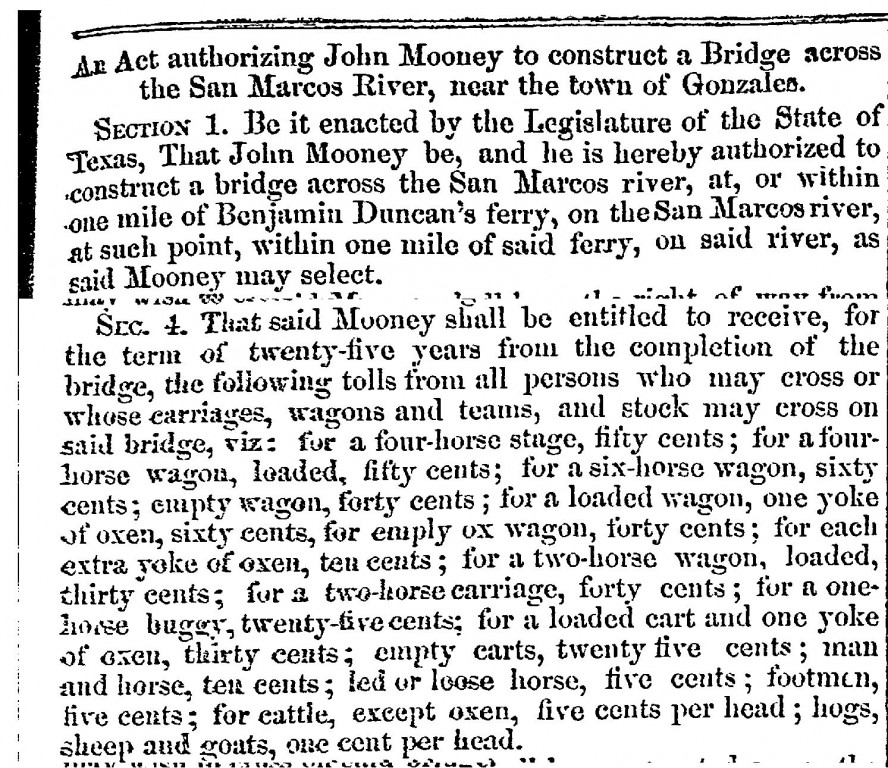 Sometimes ox freighters had to pay tolls. The Texas State Gazette on March 28, 1854 reported that John Mooney had been granted permission to build a bridge over the San Marcos River and to charge a toll for passage. The newspaper detailed the various tolls, such as sixty cents “for a loaded wagon, one yoke of oxen.”
Sometimes ox freighters had to pay tolls. The Texas State Gazette on March 28, 1854 reported that John Mooney had been granted permission to build a bridge over the San Marcos River and to charge a toll for passage. The newspaper detailed the various tolls, such as sixty cents “for a loaded wagon, one yoke of oxen.”
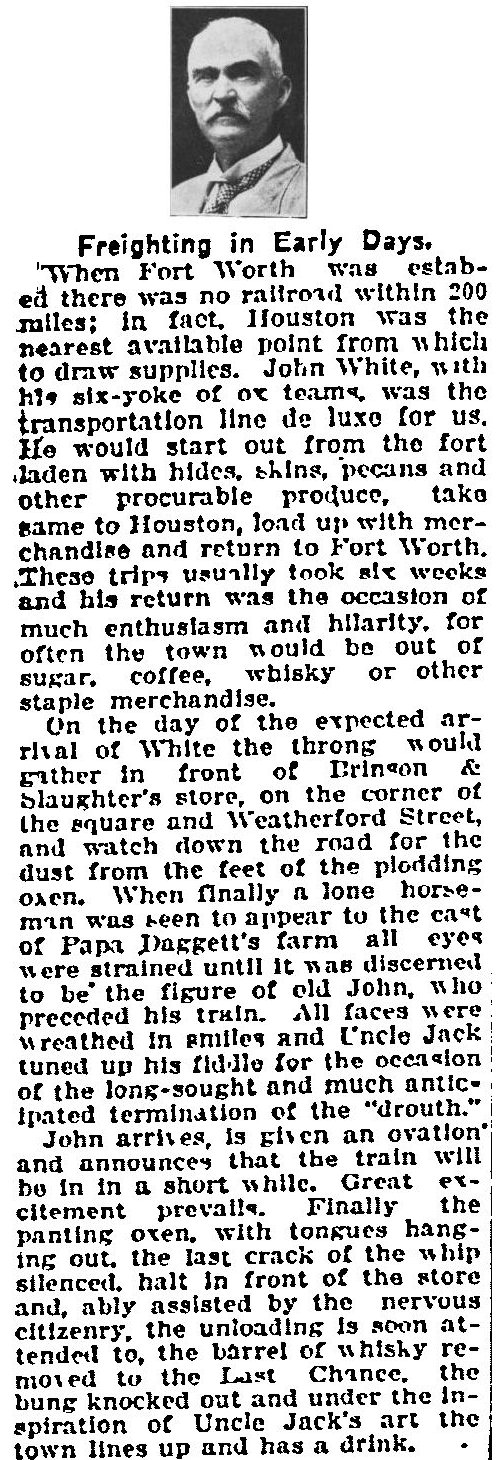 Despite the fact that ox freighter John White was out of town much of the time, his face must have been the most popular one in town in early Fort Worth. That’s how Howard Peak (pictured) remembered White in the July 9, 1922 Star-Telegram. Peak said that White’s round trip between Fort Worth and Houston took six weeks and that on the day White was expected to return to Fort Worth people would stand outside Brinson and Slaughter’s store on the courthouse square and stare down the road hoping to see the dust of White’s approaching team of twelve oxen. White’s return was “the occasion of much enthusiasm and hilarity,” especially when he brought whiskey. “Uncle Jack” Durrett played his fiddle as the men of the parched town bellied up to the bar to wet their whistles at the Last Chance Saloon.
Despite the fact that ox freighter John White was out of town much of the time, his face must have been the most popular one in town in early Fort Worth. That’s how Howard Peak (pictured) remembered White in the July 9, 1922 Star-Telegram. Peak said that White’s round trip between Fort Worth and Houston took six weeks and that on the day White was expected to return to Fort Worth people would stand outside Brinson and Slaughter’s store on the courthouse square and stare down the road hoping to see the dust of White’s approaching team of twelve oxen. White’s return was “the occasion of much enthusiasm and hilarity,” especially when he brought whiskey. “Uncle Jack” Durrett played his fiddle as the men of the parched town bellied up to the bar to wet their whistles at the Last Chance Saloon.
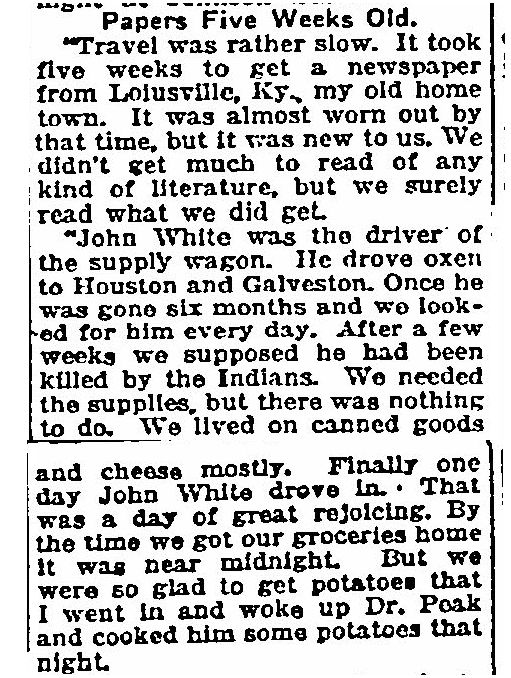 The job of the ox freighter was not easy. Roads were few and primitive: rutted, muddy when wet, dusty when dry, little more than trails. There were no motels, no HoJos or Cracker Barrels, no roadside parks, no CB radios, good buddy. On top of that, Native Americans did not always appreciate the intrusion of freighters. Mrs. M. O. Holloway was twelve years old when she came to Fort Worth in 1849. In the May 29, 1921 Star-Telegram she recalled that a newspaper from Kentucky took five weeks to reach Fort Worth and that White once was overdue and presumed killed by Native Americans. She recalled that the day White finally returned to town was “a day of great rejoicing.”
The job of the ox freighter was not easy. Roads were few and primitive: rutted, muddy when wet, dusty when dry, little more than trails. There were no motels, no HoJos or Cracker Barrels, no roadside parks, no CB radios, good buddy. On top of that, Native Americans did not always appreciate the intrusion of freighters. Mrs. M. O. Holloway was twelve years old when she came to Fort Worth in 1849. In the May 29, 1921 Star-Telegram she recalled that a newspaper from Kentucky took five weeks to reach Fort Worth and that White once was overdue and presumed killed by Native Americans. She recalled that the day White finally returned to town was “a day of great rejoicing.”
Historian Julia Kathryn Garrett wrote in Fort Worth: A Frontier Triumph that men of Fort Worth began to gather on the town square to watch for “punctual John” after he had been gone about thirty-five days. If sundown arrived before White did, his welcoming party built a bonfire on the square. When White finally arrived, his freighter was surrounded as everyone pitched in to help him unload his precious cargo. Townspeople eagerly bought salt, sugar, coffee, dried fruit, flour, shoes, and cloth on a first come-first served basis. (Picture Walmart on Black Friday. Hmmm. On second thought, don’t.)
 This is John White’s Confederate Army muster roll index card.
This is John White’s Confederate Army muster roll index card.
 But then came the railroads, creating billowing, bellowing competition for ox freighters such as John White. By the time the Texas & Pacific railroad arrived in Fort Worth in 1876 and changed everything, White was fifty-five years old with many miles behind him. By 1880 White, then sixty-one, listed his occupation as “farmer.”
But then came the railroads, creating billowing, bellowing competition for ox freighters such as John White. By the time the Texas & Pacific railroad arrived in Fort Worth in 1876 and changed everything, White was fifty-five years old with many miles behind him. By 1880 White, then sixty-one, listed his occupation as “farmer.”
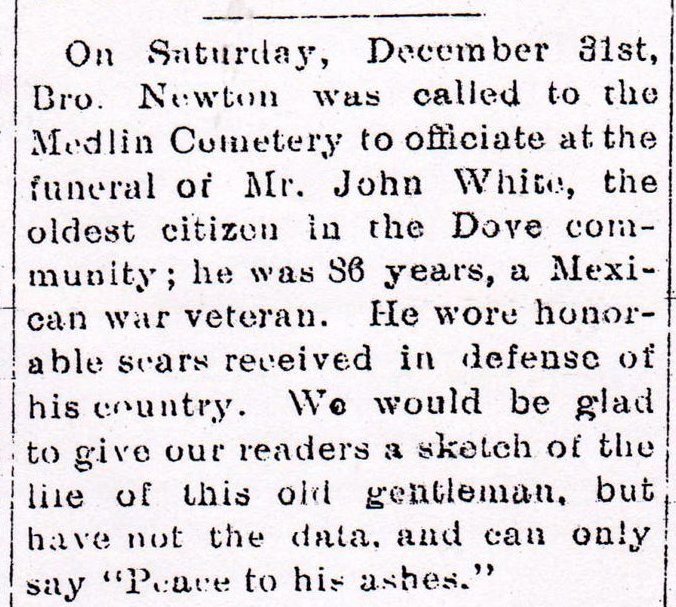 John White, Fort Worth’s first FedOx guy, died in December 1904 and is buried in Medlin Cemetery in Denton County. Clip is from the January 5, 1905 Grapevine Sun.
John White, Fort Worth’s first FedOx guy, died in December 1904 and is buried in Medlin Cemetery in Denton County. Clip is from the January 5, 1905 Grapevine Sun.
(Thanks to John White’s great-great-grandson Larry Briscoe for his help.)






Mike
Back in the days before railroads reached Fort Worth, the going freight rate was 10 cents per one hundred weight (10 CWT). Therefore, freighting from Houston would have cost merchants over $20 per hundred pounds. Imagine what a new cast iron stove cost?
Gerald Hook - Russellville, AR
Railroad History Researcher & Writer
Gerald, thank you for that added detail.